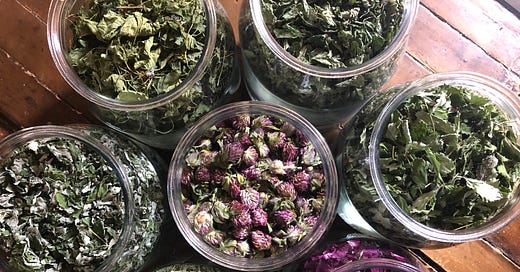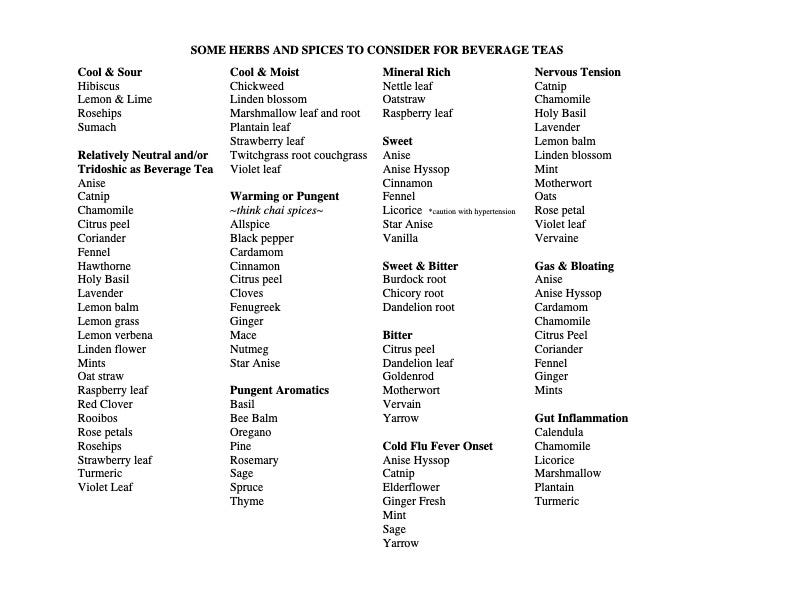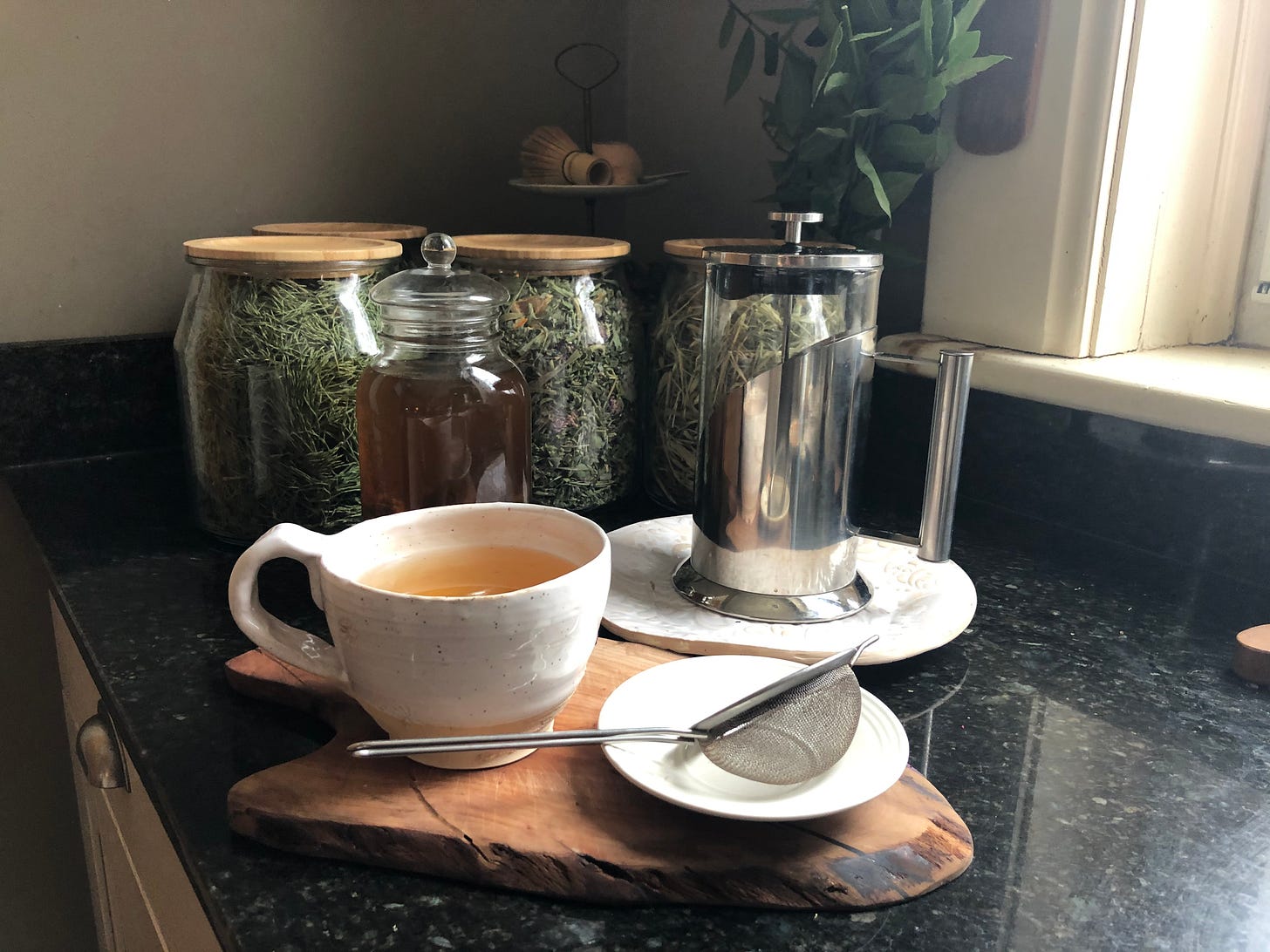Over the coming seasons I will be sharing with you some of my favourite herbs, one at a time, in greater detail. In order to set the stage for what’s up and coming, let’s first take a big picture look at herbal teas.
Traditionally herbal infusions and decoctions were the most common way that herbs were taken, especially for common household treatment of ailments. I will be focusing this post on teas for daily use, as an enjoyable beverage, and not necessarily for medicinal purposes. The herbs discussed will be those commonly found in our kitchens, gardens and backyards, as well as commonly available kitchen spices.
In addition to the simple pleasure of enjoying a warm beverage, we often reach for herbal tea as something to help us relax, perhaps even sleep; as well as strengthen or soothe our digestion. Herbs used in teas are also nutritional - providing a wide range of phytonutrients and minerals that are important contributors to overall health.
I filter my water using a reverse osmosis system, which removes all of the minerals. Because of that, I love drinking a good bit of my daily water intake in the form of herbal tea infusions. It gets the minerals into me in their most available form - the way they occur in plants. Minerals of the earth - rock and soil - are transformed into a form most useable for our bodies through the magic of plant alchemy. These are the kind of minerals our bodies thrive on.
We have evolved consuming a very wide range of plants over hundreds of thousands of years. Our bodies contain receptors for an incredibly wide range of plant constituents. These plant constituents have co-evolved with us over time, . The wider variety of plants we can include in our diets, the better. Teas are a great way to up our plant diversity intake.
TOP HERBS FOR HERBAL TEA INFUSIONS
I selected the herbs on the accompanying chart below based on relative availability and versatility when it comes to enjoying a good cup of herbal tea. They are also the sorts of herbs that are generally safe for most people to consume on a daily basis. The main caveat here would be licorice root, which can be problematic as it can contribute to high blood pressure. Listen to your body. If you don’t feel well consuming any of the herbs listed - stop taking them and try another. Everyone is unique. Listen to your body.
My top picks for herbs and spices that I find taste great on their own as a tea are as follows (though they are of course also adaptable to various blends): Lemon Balm, Peppermint, Spearmint, Raspberry leaf, Rooibos, Lemon Verbena, Linden blossom, Holy Basil (also called Tulsi), Fennel, Red clover, Chamomile, Cinnamon, Ginger. Many of these are readily available for purchase as loose leaf herbs, as well as tea bags. I much prefer loose leaf teas. These herbs make a great starting point. Easy to access, with a generally easy-to-drink flavour, depending on your tastebuds. Try them out and discover your favourites.
Below, I share a chart outlining a wider range of herbs that can be used for teas, categorized according to certain flavours, energetics and common uses. If you are not familiar with this sort of categorization, stay tuned. They will start to make sense to you as we will delve into these sorts of classifications over the coming months.
MAKING HERBAL TEAS
The simplest way to make an herbal tea is as an infusion. This method works well for most leafy herbs and flowering tops. For the more dense plant parts such as berries, roots, barks and seeds, simmering usually works best, though there are some exceptions. This process of simmering is called a decoction. Marshmallow root due to its high mucilage content does not hold up so well to heat. It is best made as a cold infusion. So what’s what?
Most herbs work well as an infusion. Traditionally, infusions were used to make teas from the dried leaf and flowering tops of herbs. To make an infusion, add about 2 tablespoons (more or less depending on your taste buds) of dried leaf/flower to a litre sized jar or teapot. Add 1 litre of boiling water, cover and allow to steep 10-30 minutes. If the herbs are very strong tasting or bitter, you may prefer to strain after 10 minutes. Strain, squeeze out the remaining liquid from the plant material into the resulting infusion and enjoy.
USING A FRENCH PRESS is a great way to be able to extract the most from your herbs when making teas, as it allows you to allows you to easily squeeze the resultant plant material when straining your tea. I have a litre-sized French press that I use only for tea, never for coffee. Though I often just use a small seive when straining my teas.
COLD INFUSIONS work better for some herbs. The classic herb we think of for a cold infusion is marshmallow root. Add 1-2 TBSP dried root to one litre of room temperature water. Cover and shake well a few times till well moistened. Allow to sit overnight, at least 8 hours. Strain, squeeze out the plant material into the resulting liquid. You can often reuse the plant material one more time for another cold infusion. You can warm up a cold infusion before drinking but best not to boil it, or overheat it, as it will lose some of its healing qualities or “glump” up.
DECOCTIONS work well for the more dense plant parts such as berries, roots, barks and seeds. Put 1-4 tablespoons dried plant material in a small non-reactive pot or glass kettle and add one litre of water. Cover and bring to a simmer. Maintain at a gentle simmer for 15-30 minutes, remove from heat, cool until warm, strain. Cinnamon bark and Ginger root are both good as a decoction though they will still add a lot of flavour to a tea when used in a regular infusion. When using a tea blend that contains leaves/flowers as well as roots/berries/barks, you can keep it simple and decoct the whole mixture together covered. Or keep the two components separate, adding the leaves and flowers once the decoction process is complete and you have removed the pot from the heat source.
FRESH HERBS often find their way into my teas during the growing season. Use significantly more herbs when making a tea using fresh herbs. Cover the pot or jar while the tea infuses in order to preserve the aromatics as much as possible. The resultant tea will generally be lighter in colour, as the plant has not undergone a drying process. When an herb is dried, it breaks down the cell wall, which then more easily allows the plant components to be infused into the tea. So, teas made with fresh plant material are generally not as densely flavoured but still have a lovely appeal of their own. I often add fresh herbs to my drinking water during the growing season to add subtle flavour and aliveness to the water. Simply add a sprig of fresh herbs to a jar of room temperature water and allow to infuse for a few hours or even overnight.
NOURISHING INFUSIONS - You can see my post here to learn more about nourishing infusions.
A STRONGER MORE MEDICINAL TEA can be made when we want to maximize the strength of the preparation for medicinal purposes. This is called a “standard” infusion or decoction. You will need a kitchen scale to measure the dried herb. For each litre of water (32oz), add 28 grams (1oz) of dried herb and follow the instructions as above. Once you have strained the plant material from the tea, squeeze it out really well. Top up the resultant tea with water to bring the total volume back to 32 oz or one litre. This makes for a strong medicinal brew, which is sometimes what’s needed.
CRAFTING YOUR OWN HERBAL TEA BLEND
When making a tea blend I like to keep these five flavours in mind, in order to create a balanced blend:
“Minerally” (traditionally associated with the salty flavour)
Pungent, spicy or aromatic
Bitter
Sour
Sweet
Think of this flavour profile for yourself when blending a tea, so you can cobble together the combination of flavours that your palate most enjoys. Over time we will go into more detail about understanding the interplay of the flavours on the energetics of our bodies.
I prefer a tea with a nice mineral rich earthy base note. Many fairly neutral or slightly astringent herbs do well here. Red raspberry is my personal favourite. Rooibos is very versatile too. Hawthorne leaf, Red clover and Strawberry leaf are also similarly neutral to my tastebuds but don’t have the astringency that I love from raspberry leaf. Oat straw, Plantain and Stinging nettles add mineral rich flavour - though I find they really taste best when combined with other herbs.
The addition of some sort of root can add a great grounding flavour. My favourite is burdock root. Consider also Dandelion root or Couch grass root. Although roots are traditionally decocted and not infused, I find they still impart plenty of flavour when added to an infusion.
I prefer a tea that has a slight pungent edge so I will often add a small amount of Ginger or Citrus peel. I love to add dehydrated sliced organic orange with the peel. This gives not only a pungency to the tea, but also some bitter and a mild tangy edge. For other herbs to consider that fulfill these flavour categories, refer to the chart above.
Experiment and come up with your own favourite blends. Everyone’s taste buds are different. The chart above gives you a starting point regarding flavours and herbs to choose from. For an example of nicely balanced blend see this formula .
HARVESTING TO CREATE YOUR OWN PERSONAL BLEND
Throughout the growing season as things come into their prime, I gather and dry a wide range of herbs for my yearly tea blend. I gather from the herbs growing in my gardens, from trees and shrubs, and from the many plants that grow abundantly in the wild on the farm. Every year it’s a bit different based on the year’s unique weather patterns and growing conditions, as well as the timing of my own calendar. Sometimes I will make a couple of blends, based on my mood, taste buds and what is available. You can see the blends I made from my 2023 harvest in this post on Nourishing Infusions. It’s a wonderful way to engage with and experience the unfolding growing season and a great way to connect to nature and the plants. Getting to know them, befriending them and cultivating a relationship with them. Join me over the coming seasons as we explore the plants that we can find growing in our bioregion as well as those we can plant in our yards and gardens.
RESOURCES
Many of these herbs are available both from Karen at Tea Leaves in Stratford and from Almut at Pfennings in St. Agatha. You can also check out your favourite health food store for various options.
If you are looking to source plants for your garden, check out Tamara’s offerings at Firmly Rooted - available in the Spring. Consider also ordering from Richters Herbs online. I will be sharing a post on best plants, trees and shrubs for your garden and backyard in the coming month in order to help you plan the year ahead.







